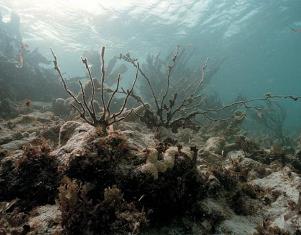Topics 8 & 18
Including International-mindedness, TOK, and 'Utilization' in Acids and bases
International-mindedness
![]()
![]() 1. The destruction of coral reefs
1. The destruction of coral reefs
 One of the problems of emissions of acidic polluting gases is that their effects are often felt far from where they are emitted (see 2. below). The problems faced by the Great Barrier Reef are well documented and there is serious concern that they it could be completely destroyed within the next thirty five years. The main cause of the destruction is the increase in the concentration of dissolved carbon dioxide in the world's oceans. This causes destruction of the tiny polyps that make up the limestone reef. The main reason for this is the increased acidification of the oceans by the increase in dissolved carbon dioxide. The warmer temperatures of the water near the surface caused by global warming due to increased levels of carbon dioxide in the atmosphere are also exacerbating the problem.
One of the problems of emissions of acidic polluting gases is that their effects are often felt far from where they are emitted (see 2. below). The problems faced by the Great Barrier Reef are well documented and there is serious concern that they it could be completely destroyed within the next thirty five years. The main cause of the destruction is the increase in the concentration of dissolved carbon dioxide in the world's oceans. This causes destruction of the tiny polyps that make up the limestone reef. The main reason for this is the increased acidification of the oceans by the increase in dissolved carbon dioxide. The warmer temperatures of the water near the surface caused by global warming due to increased levels of carbon dioxide in the atmosphere are also exacerbating the problem.![]()
![]() 2. Our waste gases - your problem?
2. Our waste gases - your problem?
In 1983 the then Swedish Minister for Agriculture noted,
"For decades we have been using the atmosphere as a rubbish dump, and now the dire effects of our thoughtlessness are beginning to catch up with us - all of us, wherever we may be."
He was referring to the fact that more than half of the sulfuric acid falling as acid rain on Sweden emanated from the UK and other European countries. This had led to over 18,000 lakes in Sweden suffering from acid pollution with some 4,000 of them seriously affected. Some twenty years later it seemed as if this commonly held view of Europe polluting Scandinavia may not actually be correct. An article in 2003 quotes a scientific report by the state run Norwegian Forestry Institute which found that acid rain carried over by winds from Europe counteracted the pollution caused by local industries. It has in fact helped the forests to increase by one quarter during recent decades. It is difficult to know who to believe but both sources do acknowledge that acidic gaseous emissions from factory chimneys in Europe do have an effect on Scandinavian trees - the problem is that they disagree on what the effect is.
Theory of Knowledge
There are several references to Theory of Knowledge in Topic 8 on the syllabus. Sub-topic 8.1 Theories of acids & bases refers to the different definitions of acids and bases and asks how explanations in chemistry differ to explanations in other subjects such as history. Sub-topic 8.3 pH scale asks why it is important to have just one 'scientific' language. Sub-topic 8.4 Strong & weak acids & bases asks how technologies such as pH and conductivity probes which extend our senses, change or reinforce our view of the world and sub-topic 8.5 Acid deposition asks whether scientific vocabulary (which uses precise definitions) simply communicates our knowledge in a neutral way or whether its terminology is value-laden in some way. For example, all rain is naturally acidic but not all rain is ‘acid rain’.
![]()
![]() 1. Theories of acids and bases
1. Theories of acids and bases
Normally definitions in chemistry are very precise and unambiguous. It is interesting that there are several completely different ways of defining an acid or a base and many of these ways are still used depending upon the context. Under some definitions (e.g. Arrhenius or ionic theory) water is neutral whereas under other definitions (e.g. Brønsted-Lowry or Lewis) it can act as an acid or a base - who says chemistry is logical! The reason for this is probably historical. Even non-chemists have understood the idea of acidity for centuries as it is associated with sourness - and in fact the German word sauer and the Norwegian word syre are still used to describe acids in those languages. Antoine Lavoisier came up with the first chemical definition of an acid as an oxide of a non-metal with water. It was soon realised that hydrochloric acid, HCl, and prussic acid, HCN, did not fit this definition and the first definition that is still used today was put forward by Svante Arrhenius who defined an acid in terms of a substance that produces hydrogen ions in aqueous solution - the ionic theory of acids. For most non-chemistry specialists this definition is the most useful and forms the basis of the pH scale which measures the hydrogen ion concentration in a logarithmic scale.
 The term “pH” was invented by the Danish chemist Søren Sørenson (1868–1939) while he was working as head of the laboratory at the Carlsberg brewery in Copenhagen. He realized that it was much easier to describe weakly acidic solutions in terms of pH rather than using tedious expressions such as “the concentration of hydrogen ions equals one-hundred-thousandth of a mole in one cubic decimetre of solution” when describing a solution with a pH of 5. When I visited the brewery I was amused to find that one of the horses they used to pull the larger carts was called IB (see right).
The term “pH” was invented by the Danish chemist Søren Sørenson (1868–1939) while he was working as head of the laboratory at the Carlsberg brewery in Copenhagen. He realized that it was much easier to describe weakly acidic solutions in terms of pH rather than using tedious expressions such as “the concentration of hydrogen ions equals one-hundred-thousandth of a mole in one cubic decimetre of solution” when describing a solution with a pH of 5. When I visited the brewery I was amused to find that one of the horses they used to pull the larger carts was called IB (see right).
To help explain the acidity of salts, such as ammonium chloride, or the basicity of salts, such as sodium carbonate, Brønsted-Lowry introduced their definition and the concept of conjugate base or conjugate acid. This can be useful when explaining how buffer solutions work. Gilbert Lewis (of Lewis structures fame) extended this further by involving the idea of transfer of pairs of electrons and under this very general definition species such as iron(II) ions, Fe2+, which contain no hydrogen ions act as a Lewis acid when they form a complex ion with ligands such as the cyanide ion, CN–. Under this definition many organic reactions are acid base reactions as they do involve the transfer of pairs of electrons (often represented by using a 'curly arrow' when describing organic mechanisms)
![]()
![]() 2. The language of acids and bases
2. The language of acids and bases
Language is a key element in the ways of knowing. As you can read on the section on Language of Chemistry there are many examples where the meaning of words used in chemistry can be very different to their everyday meaning in English. This is important as student sometimes cannot answer a chemistry question not because they do not know the chemistry but because they do not understand the language it is phrased in. The words strong and concentrated in English can both be used when talking about drinks and effectively they both mean concentrated. For example, 'a strong cup of tea' means one that contains more tea than usual. In chemistry of course they have completely different meanings. A strong acid is one that is completely dissociated and a concentrated acid is one that contains a relatively large amount of moles of acid per litre. In English acids are normally thought of as being corrosive and this again carries the concept of strong. However hydrofluoric acid is a weak acid but is very corrosive as in chemistry corrosive is concerned with reactivity not with strength or concentration.
'Utilization'
![]()
![]() 1. Acid rain - an environmental problem
1. Acid rain - an environmental problem
It would be difficult to talk about acids and bases in the context of 'Utilization' and not include reference to acid rain. Because of the fact that acidic pollutant gases are carried by winds across international borders it also relates strongly to International-mindedness (see above). Acid deposition is now covered in this topic under sub-topic 8.5. It can be useful to get students to work out the pH of a saturated solution of carbonic acid to explain why acid rain is defined as precipitation with a pH of less than 5.6. For all students it is easy to see the effect of a tenfold increase in hydrogen ion concentration as the pH falls from 5.6 to 4.6. This can be done simply by looking at a table of how sensitive aquatic life is to pH (e.g. see pages 44-45 in this article from the United States Environmental Protection Agency).
The general effects of lowering the pH on aquatic life are that harmful effects start to become apparent when the pH of rivers, lakes and ponds falls below 6. Below pH 5 populations of fish start to disappear and below a pH of 4.5 the water is essentially devoid of fish. This is not only due to the direct lowering of pH but also due to an increase in aluminium ions, Al3+, which are leached from rocks and released into the water. This can asphyxiate fish by blocking their gills as it stimulates excessive mucus formation.
For precise details about how pH affects particular species you can download a pdf file on the pH Requirements of freshwater aquatic life ![]() from Robertson-Bryan Incorporated.
from Robertson-Bryan Incorporated.
![]()
![]() 2. Effect of acid deposition on buildings - an economic problem
2. Effect of acid deposition on buildings - an economic problem
The term ‘acid rain’ was first used by Robert Angus Smith (1817-1884) a Scottish chemist who wrote,
"It has often been observed that the stones and bricks of buildings crumble more readily in large towns where much coal is burnt.... I was led to attribute this effect to the slow but constant action of acid rain."

Because of the burning of fossil fuels to produce sulfur dioxide and the emissions of nitrogen oxides from internal combustion engines many buildings have been seriously affected by acid rain. Older buildings which are more traditionally made from limestone suffer more than modern buildings. The cost of maintaining and renovating famous monuments such as the Parthenon in Athens, many of the cathedrals and minsters in Europe, the Taj Mahal in India and the Colosseum in Rome are well documented but the cost of repairing more ordinary buildings is even greater. The need to reduce reliance on fossil fuels is not only to conserve energy and reduce global warming but also to reduce damage from acidic emissions.

 IB Docs (2) Team
IB Docs (2) Team